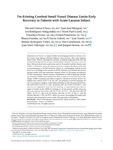Pre-existing cerebral small vessel disease limits early recovery in patients with acute lacunar infarct

Not available until 9999-99-99
View/
Use this link to cite
http://hdl.handle.net/2183/39462Collections
- Investigación (FCS) [1293]
Metadata
Show full item recordTitle
Pre-existing cerebral small vessel disease limits early recovery in patients with acute lacunar infarctAuthor(s)
Date
2019-11Citation
Gómez-Choco M, Mengual JJ, Rodríguez-Antigüedad J, Paré-Curell M, Purroy F, Palomeras E, Fuentes B, Ustrell X, Tembl J, Rodríguez-Yañez M, Castellanos M, Martí-Fabregas J, Serena J. Pre-existing cerebral small vessel disease limits early recovery in patients with acute lacunar infarct. J Stroke Cerebrovasc Dis. 2019 Nov;28(11):104312.
Abstract
[Abstract]
Background and purpose: To assess whether neuroimaging markers of chronic cerebral small vessel disease (cSVDm) influence early recovery after acute ischemic stroke (AIS).
Methods: Retrospective analysis of patients diagnosed with AIS and included in the Spanish Neurological Society Stroke Database.
Inclusion criteria: (1) Brain MRI performed after acute stroke and (2) Premorbid modified Rankin scale (mRS) = 0.
Exclusion criteria: (1) Uncommon stroke etiologies, (2) AIS not confirmed on neuroimaging, or (3) Old territorial infarcts on neuroimaging. Patients scored from 0 to 2 according to the amount of cSVDm. Patients were divided into lacunar ischemic stroke (LIS) and nonlacunar ischemic stroke (NLIS) groups according to TOAST classification.
Primary outcome: Distribution of mRS at discharge.
Secondary outcomes: NIHSS improvement more than or equal to 3 at 24 hours and at discharge, NIHSS worsening more than or equal to 3 points at 24 hours.
Results: We studied 4424 patients (3457 NLIS, 967 LIS). The presence of cSVDm increased the risk of worsening 1 category on the mRS at discharge in the LIS group ([1] cSVDm: OR 1.89 CI 95% 1.29-2.75, P = .001. [2] cSVDm: OR 1.87, CI 95% 1.37-2.56 P = .001) and was an independent factor for not achieving an improvement more than or equal to 3 points on the NIHSS at discharge for all the patients and the LIS group (all stroke patients: [1] cSVDm: OR 0.81 CI 95% .68-.97 P = .022. [2] cSVD: OR 0.58 CI95% .45-.77, P = .001./LIS: [1] cSVDm: OR 0.64, CI 95% .41-.98, P = .038. [2] cSVDm: OR 0.43, CI 95% .24-.75 P = .003).
Conclusions: Pre-existing SVD limits early functional and neurological recovery after AIS, especially in LIS patients.
Keywords
Small vessel disease
Lacunar stroke
Lacune
Microbleed
Stroke recovery
White matter hyperintensity
Lacunar stroke
Lacune
Microbleed
Stroke recovery
White matter hyperintensity
Editor version
ISSN
1052-3057





